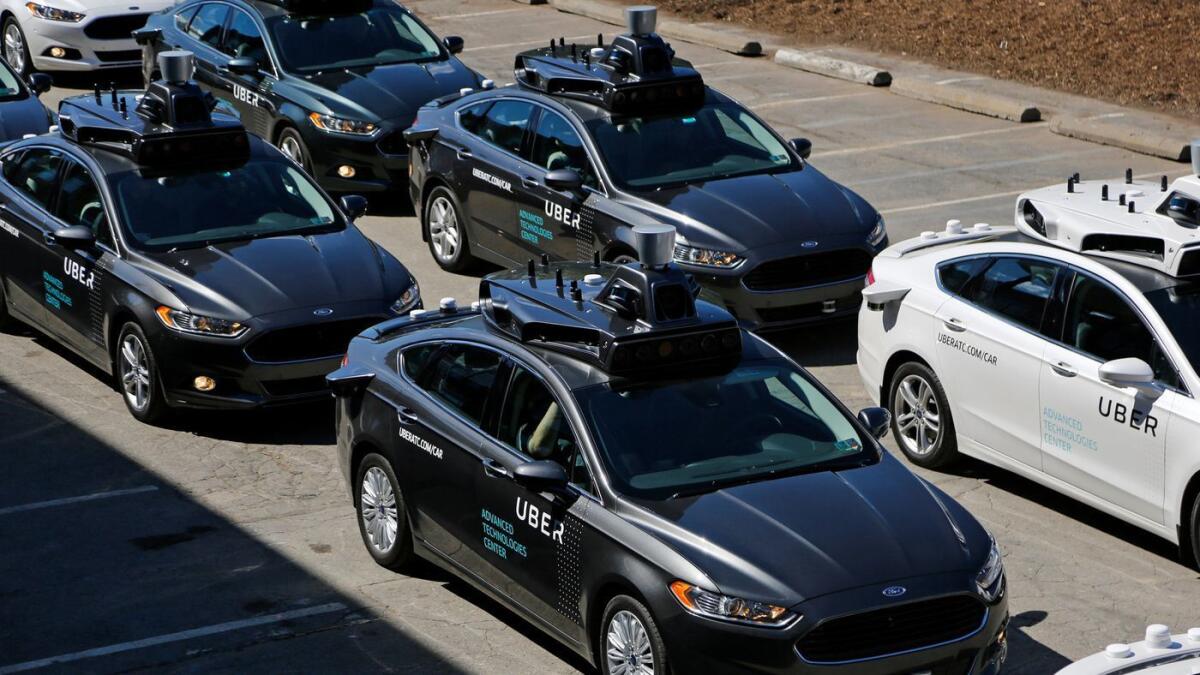Editorial: If we don’t plan for them, autonomous vehicles could make our car-dominated transit system even worse

The prospect of self-driving robot cars has often seemed like a futurist’s dream, years away from materializing in the real world. Well, the future is apparently now. Actually, next month.
The California Department of Motor Vehicles will begin issuing permits in April for companies to test truly self-driving cars on public roads. Up to this point, California has required autonomous vehicles to have an operator behind the wheel, ready to take control if needed. Under the new rules adopted late last month, test cars don’t even have to have a steering wheel. The state also cleared the way for companies to sell or lease self-driving cars, and for companies to operate driverless taxi services.
California, it should be noted, isn’t leading the way here. Companies have been testing their vehicles in cities across the country. Uber has been operating around 200 self-driving Volvo SUVs in Pittsburgh. Waymo — Alphabet Inc.’s self-driving car company — has been giving free rides in autonomous minivans to passengers in suburban Phoenix; it plans to roll out a paid service this year. Ford has been testing a self-driving pizza delivery car in Ann Arbor, Mich., and is expanding the pilot to Miami.
Do we want to replicate — or even worsen — the traffic of today with driverless cars?
How soon before driverless cars are commercially available and omnipresent on our roads? Although it’s hard to predict because the technology is developing so rapidly, we’re likely to see significant numbers in more than a year but less a decade. However long it takes, the technology has the potential to dramatically change our transportation systems and our cities, for better or for worse, depending on how the transformation is managed.
While much of the debate so far has been focused on the safety of driverless cars (and rightfully so), policymakers also should be talking about how autonomous vehicles can help reduce congestion, cut emissions and offer more convenient, affordable mobility options. The arrival of autonomous vehicles is an opportunity to ensure that those vehicles are environmentally friendly and, more radically, shared — meaning the end of ubiquitous car ownership.
Do we want to replicate — or even worsen — the traffic of today with driverless cars? Imagine a future where most adults own individual autonomous vehicles. They tolerate long, slow commutes on packed highways because they can work, entertain themselves or sleep on the ride, which encourages urban sprawl. They take their driverless car to an appointment and set the empty vehicle to circle the building to avoid paying for parking. Instead of walking a few blocks to pick up a child or the dry cleaning, they send the self-driving minivan. The convenience even leads fewer people to take mass transit — an unwelcome side effect researchers have already found in ride-hailing services such as Uber and Lyft. The streets would be cluttered with robot cars.
That’s the worst-case scenario. Alternatively, autonomous vehicles could pave the way for a new mobility model that offers a variety of transportation services that are more convenient, cheaper and more sustainable than owning a car. There could be on-demand robot taxis or carpools, shuttles and paratransit services that integrate with rail lines and buses. The idea would be to move more people, faster and at lower cost, in fewer single-occupant cars. There would be less need for parking garages, freeing up those lots for housing or offices, or for parking spaces on streets, allowing for more bike routes and broader sidewalks.
A study from UC Davis estimated that replacing fossil-fuel-powered private cars worldwide with electric, autonomous and shared systems could reduce carbon emissions from transportation 80% and cut the cost of transportation infrastructure and operations 40% by 2050. Fewer emissions and cheaper travel sound pretty appealing.
The first commercially available driverless cars will almost certainly be fielded by ride-hailing services, considering the cost of autonomous driving technology as well as liability and maintenance issues. But driverless car ownership could increase as the prices drop and more people become comfortable with the technology.
Policymakers should start thinking now about how to ensure the advent of autonomous vehicles doesn’t extend the worst aspects of the car-dominated transportation system we have today. The looming technological leap presents a chance for cities and states to develop transportation systems designed to move more people, more efficiently and more affordably. The car of the future is coming. We just have to plan for it.
Follow the Opinion section on Twitter @latimesopinion and Facebook
More to Read
A cure for the common opinion
Get thought-provoking perspectives with our weekly newsletter.
You may occasionally receive promotional content from the Los Angeles Times.










